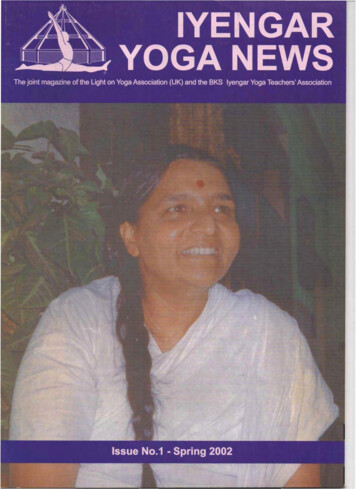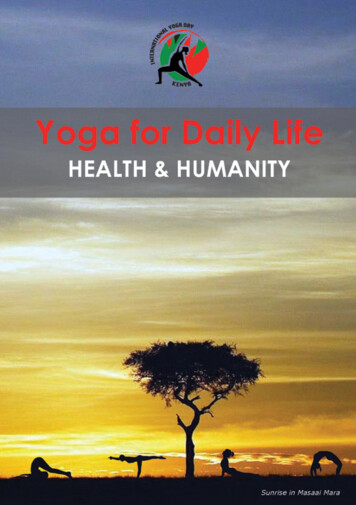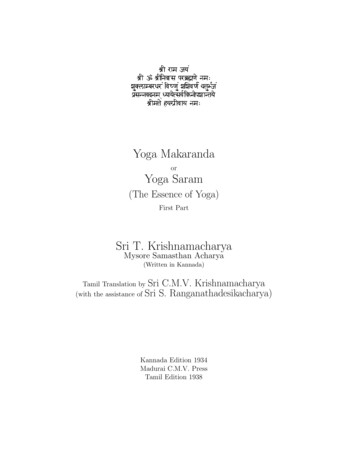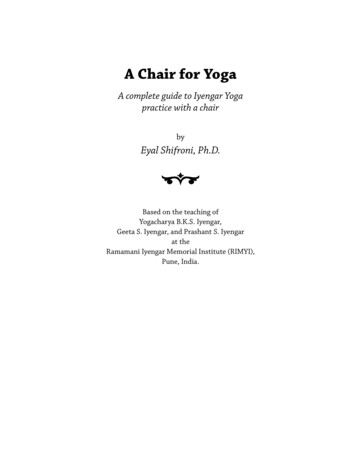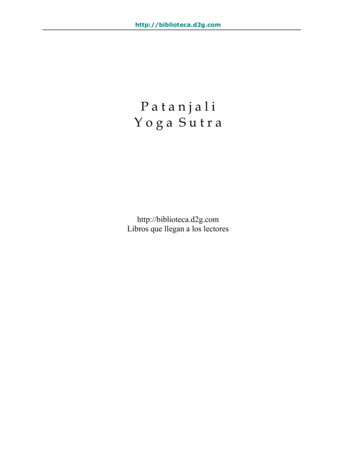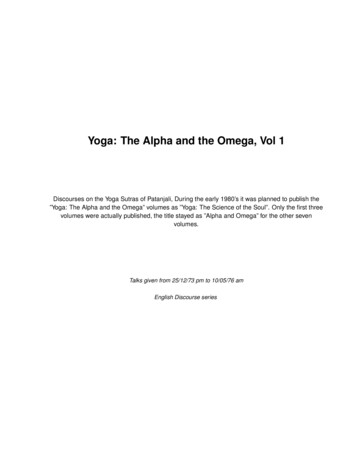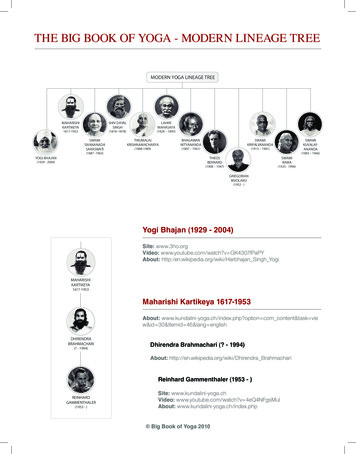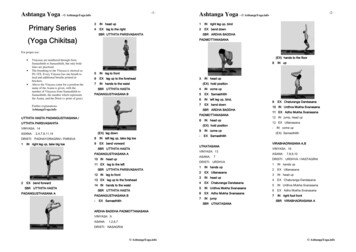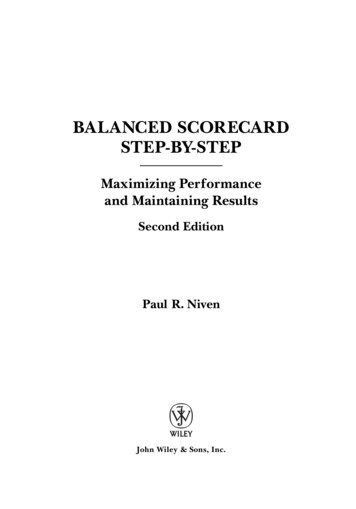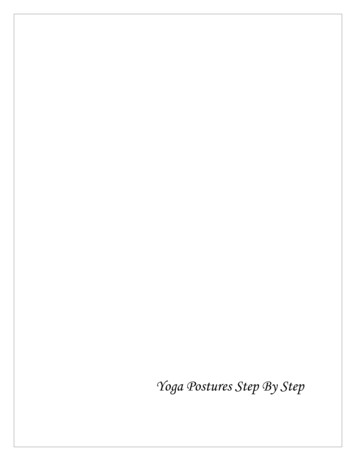
Transcription
Yoga Postures Step By Step
1Table of ContentsSl. No Sanskrit ya – NamaskarAkarna – Dhanur - asanaAnjaneya – asanaArdha Chandra - asanaArdha – Matsyendra - asanaBaddha Kona AsanaBala AsanaChakra AsanaDhanur - asanaEkapada - asanaGaruda – asanaGomukha – asanaHala - sanaHasta – Pada – angustaMatsya - asanaNaga – asanaNataraja asanaPadma – asanaParivritta – parshvakonaPavana mukta asanaSarvanga – asanaShalabha – asanaShava – asanaSiddha - asanaSimha – asanaSirsha – asanaTada – asanaTrikona – asanaUgra – asanaUshtra – asanaVajra – asanaVira – asanaVriksha – asanaVrischika – asanaEnglish NameSun SalutationShooting Bow PostureSalutation PoseHalf Moon PostureHalf Spinal Twist PostureRestrained angle PostureChild PostureWheel PostureBow PostureOne Legged PostureHalf Spinal Twist PostureCow Face PosturePlough PostureHand – foot big toe PoseFish PostureCobra PostureKing of the Dance PostureLotus PostureTurned Side angle PostureWind – releasing postureShoulder stand postureLocust PostureCorpse PostureAccomplished PostureLion PostureHeadstand PostureMountain PoseTriangle PosePowerful PostureCamel PostureDiamond PostureHero PostureTree PoseScorpion PoseDifficulty 121314161718192021222324252627283031323334343536
2Yoga Postures Step-by-Step1. The Sun salutation - SuryanamaskarPosture: Surya-namaskar - Sun SalutationTranslation: The Sanskrit word surya means sun. Namaskar is thePronunciation:Difficulty:STEP ONE:Hindi word for Namaste, from the root nam, to bow.Namaskar means salutation, salute, greeting orpraise.soor-yee-ah-nahma-skar(3)Stand facing the direction of thesun with both feet touching.Bring the hands together, palmto-palm, at the heart.STEP THREE:Exhale slowly bending forward,touching the earth with respectuntil the hands are in line withthe feet, head touching knees.STEP FIVE:While exhaling, bring theleft foot together with theright. Keep arms straight,raise the hips and align thehead with the arms,forming an upward arch.STEP SEVEN:Inhale and slowly raisethe head and bendbackward as much aspossible, bending thespine to the maximum(as in the naga-asana).STEP TWO:Inhale and raise the arms upward. Slowly bendbackward, stretching arms above the head.STEP FOUR:Inhale and move the right leg back away from thebody in a wide backward step. Keep the handsand feet firmly on the ground, with the left footbetween the hands. Raise the head.STEP SIX:Exhale and lower the body to the floor until thethe feet, knees, hands, chest, and forehead aretouching the ground.STEP EIGHT:While exhaling, bring the left foot together withthe right. Keep arms straight, raise the hips andalign the head with the arms, forming an upwardarch.
3STEP NINE:STEP TEN:Inhale and move the rightleg back away from thebody in a wide backwardstep. Keep the hands andfeet firmly on the ground,with the left foot betweenthe hands. Raise the head.STEP ELEVEN:Exhale slowly bending forward, touching the earth withrespect until the hands are in line with the feet, headtouching knees.STEP TWELVE:Inhale and raise the armsupward. Slowly bendbackward, stretching armsabove the head.Stand facing the direction of the sun with both feettouching. Bring the hands together, palm-to-palm, at theheart.2. Akarna-Dhanura-asana – The Shooting – bow - PosePosture: Akarna-dhanura-asanaThe Shooting-bow PoseTheSanskrit word karna means ear and the prefix "a" meansTranslation:near to or towards. Dhanur means bow-shaped, curved or bent.The "bow" here referred to is a bow as in "bow and arrow."Literally we could translate this as the near-the-ear bowposture but because of the obvious appearance of the posturewe'll call it the shooting bow posture.Pronunciation:Difficulty:ah-car-nah da-noor ah-sa-na(6) Requires flexibility of hips and legs.
4Instructions:1.2.3.4.Sit on the floor with the legs together and extended straight out in front. Keep the back straight,shoulders level and head straight. Place the hands, palms down, flat on top of the thighs theninhale deeply.Exhale and reach down and loop the forefinger of the right hand around the big toe of the rightfoot and grasp the left foot with the left hand.Inhale and pull the right foot back placing the big toe next to the right ear. Straighten the backas much s possible and hold the posture for the duration of the inhale breath.Exhale and return to the seated position of step #1 then repeat the posture on the opposite side."Having caught the toes of the feet with both hands and carried them to the ears by drawing the body likea bow, it becomes Dhanura-asana."The Hatha-Yoga-Pradipika I.27.Comments:While practicing this posture imagine yourself as an archer with the gaze focused on the target and thearrow firmly yet gracefully being pulled back in the bow. Hold the posture steady as an archer would holdthe arrow aimed at its target. Return the foot to the floor gently. This simple technique will help cultivatea focused and unwavering attention.Variations:Reverse the hands and feet so that that the right hand pulls the left foot to the left ear and vice versa. Thefoot gets pulled under the outstretched arm.3. Anjanaya-asana – The Salutation PosePosture: Anjanaya-asana - The Salutation PoseTranslation: The Sanskrit word anjaneya means salutation or praise fromthe root anj which means to honor, to celebrate, to na(7)Instructions:Sit comfortably in the vajra-asana (thunderbolt pose).Kneel up on your knees until your back, buttocks and thighs are aligned.Extend your left foot foward bending your left knee at about a 90 degree angle.Place the palms of your hands together at the heart in the anjali-mudra.Raise your arms stright up keeping the palms together while bending the headbackward and looking up.6. Slowly bend backward stretching the arms backward and straightening out the rightleg. Hold this position for as long as comfortable while breathing gently through thenostrils.1.2.3.4.5.
57. Come back to the vajara-asana (thunderbolt pose) then reverse the posture byalternating legs.Comments:The anjaneya-asana combines several postures and mudras (gestures) in a fluid, evolving flow thatcombines motion, stretching and holds. It delivers great benefits for the back, arms, chest, legs and hips.Regular practice will strengthen concentration and improve balance.Perform this posture with a sense of reverence and praise. Take a moment to reside in silence and peaceas your hands are held at the heart in the gesture (mudra) of salutation (anjali-mudra). Keep theintention of praise in mind as you extend your arms skyward. Feel your entire body-mind-heart extendingoutward in recognition of the sacredness of life.Duration/Repetitions:Repeat twice on each side.4. Ardhachandra-asana – The Half – moon PosePosture: Ardhachandra-asana - The Half-moon PoseTranslation: The Sanskrit word ardha means "half," and the word chandrameans "moon," thus, this is the "half moon" sa-na(2)Instructions:1.2.3.4.5.Stand in the tada-asana (Stand with both feet touching from the heel to the big toe,keeping the back straight and the arms pressed slightly against the sides with palmsfacing inward.Bring the hands together at the chest with palms lightly pressed against each other(the Anjali-mudra).Inhale and raise the arms straight up keeping the palms pressed lightly together.Arch your body backwards keeping your arms alongside your neck and head, tilt thehead backward and hold. Keep your knees straight while holding posture.Slowly return to the tada-asana.
6Comments:The ardha-chandra-asana is a basic stretching and balancing pose that benefits principly the lower back,abdomen and chest. It isequally suitable for use in your stretching routine as well as formal asanapractice.This pose is also one of the postures that are are sequenced in surya-namaskar (the Sun Salutation).Duration/Repetitions:Repeat ardha-chandra-asana two to three times.5. Ardha-matsyendra-asana – The Half Spinal Twist PosePosture: Ardha-matsyendra-asanaThe Half Spinal Twist PoseTranslation: Ardha means half. Matsyendra is one of many Siddhas orPronunciation:Difficulty:masters who where accomplished Yogis mentioned in themedieval Yoga text the Hatha-Yoga-Pradipika. This postureposture is traditionally called the Spinal Twist because thespinal column is twisted gently.ard-ha-mat-syen-drah-sa-na(4)"Keeping the abdominal region at ease like the back, bending theleft leg, place it on the right thigh; then place on this the elbow ofthe right hand, and place the face on the palm of the right hand,and fix the gaize between the eye-brows. This is called Matsyendraposture."Hatha-yoga-pradipika I.37Instructions:Sit in any comfortable cross-legged position.1. Straighten the legs out in front. Bend the right knee and bring the heel of the rightfoot close to the left hip.2. Inhale and bend the left knee upward and place the left foot flat on the floor to theright of the right leg with the ankle touching the right thigh.3. While turning the spine to the left straighten the right arm bringing it around to theoutside of the left knee and grasp the left foot with the right hand.4. Turn your head as far as possible to the left and bend the left arm behind your back.Keep your spine, neck and head aligned and continue to exert effort at turning to theleft.5. Repeat the posture the other side by reversing directions 2-6.
7Comments:The Half Spinal Twist is one of the best Yoga postures for cultivating flexibility and strength in the spine. Itsooths stiff necks and upper back tension caused by stress, poor posture, or prolonged periods of sitting inone position.The alternating compression and release of the abdominal region flushes this area with blood andmassages the internal organs. Muscles of the stomach and hips are also toned from repeated practice ofthe Half Spinal Twist.Duration/Repetitions:The posture can be held for as long as you are comfortable. (One repetition consists of performing theposture on each side. Two to three full repetitions should be done at each session.6. Baddha-kona-asana – The Restrained Angle PosePosture: Baddha-kona-asanaThe Restrained Angle PoseTranslation: The Sanskrit word baddha means a bond, chain, caught orPronunciation:Difficulty:restrained. The word pada means foot, and kona means corneror angle therefore this is the restrained-foot-angle posture.ba-dah-cone-ah-sa-na(4)Instructions:1.Sit on the floor with the legs together and extended straight out in front. Keep theback straight, shoulders level and head straight. Place the hands, palms down, flat ontop of the thighs then inhale deeply.2. Exhale and bend the knees drawing the feet toward the torso.3. Place the soles of the feet together, clasp the hands over the feet interlocking thefingers pulling the feet closer and placing the heels against the perineum. The outeredge and small toe of each foot should touch the floor.4. Lower the knees to the floor and keep the back straight. Use the elbows to press downon the thighs if necessary to bring the calves and knees to the floor. Hold the posturebreathing gently through the nostrils.5. Release the posture and sit with the legs extended out and hands on the thighs.
8Comments:Regular practice of the baddhakona-asana stretches the knees and stimulates circulation in the legs. Itshould be practiced frequently until one is comfortable sitting in the padma-asana. The main areas of thebody that are stimulated, besides the legs, are the stomach, pelvis and lower back. It is said to keep thekidneys, prostate and bladder healthy. The baddha-konasana is one of the few postures that can bepracticed comfortably soon after eating.Duration/Repetitions:Hold the posture from thirty seconds to two minutes depending on comfort. Repeat two or three times.7. Bala-asana – The Child PosePosture: Bala-asana - The Child PoseTranslation: The Sanskrit word bala means child.Pronunciation: ba-lah-sa-naDifficulty: (2)"As inumerable cups full of water, many reflections of the sun areseen, but the sun is the same; similarly individuals, like cups, areinumerable, but spirit, like the sun, is one."The Shiva-samhita I.35 II.42-43.Instructions:1.2.3.4.5.Sit on your knees with your feet together and buttocks resting on your heels. Separateyour knees about the width of your hips. Place your hands on your thighs, palmsdown. (This is the vajra-asana or Thunderbolt Pose).Inhale deeply, then exhale as you bring your chest between your knees while swingingyour arms forward.Rest your forehead on the floor, if possible, and then bring your arms around to yoursides until the hands on resting on either side of your feet, palms up.Breath gently through your nostrils as you hold the posture. Hold for about one to twominutes. Then return to asn upright kneeling position with your back straight and yourhands on your thighs.Repeat the posture at least one more time.
9Comments:The bala-asana is one of the more relaxing Yoga postures and can easily be done by beginners. As part ofyour Yoga routine it is best used as a counter-pose to any posture that stretch the spine backward (suchas thenaga-asana, the dhanura-asana, the chakra-asana, the ushtra-asana, etc.)The bala-asana gently stretches and relaxes the shoulders, neck, back muscles and thighs.Duration/Repetitions:The bala-asana can be held for as long as is comfortable. Repeat at least twice if it is held for less than aminute.8. Chakra-asanaPosture: Chakra-asanaThe Wheel PoseTranslation: Chakra, from the root cak ("to move") means wheel andPronunciation:Difficulty:therefore this is the Wheel Posture.The cakra-asana is also known as the urdhva-dhanurasana.Urdhva means raised, elevated or upright and dhanur meansbow. Both "wheel posture" and "raised bow posture" describethe appearance of this asana.chu-krah-sa-na(8) (full variation), (3)
2 Yoga Postures Step-by-Step 1. The Sun salutation - Suryanamaskar Posture: Surya-namaskar - Sun Salutation Translation: The Sanskrit word surya means sun.
